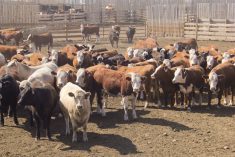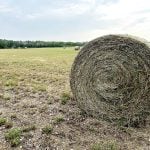U.S. corn futures surged five per cent to a three-week high on Thursday after the U.S. Agriculture Department slashed its forecast for global ending stocks and estimated the drought-plagued U.S. crop will be the smallest in six years.
The government narrowly increased the number of U.S.-harvested corn acres, keeping the door open for further declines as farmers abandoned fields that would produce no grain due to the most extensive drought in 56 years in the world’s biggest corn, soybean and wheat exporter.
Soybeans gained for the first time in five sessions at the Chicago Board of Trade (CBOT) after the USDA figures showed a stocks-to-use ratio that would be the tightest since the mid-1960s.
Read Also

U.S. livestock: Feeder cattle hit contract highs on tight supply
Chicago | Reuters – All Chicago Mercantile Exchange feeder cattle futures and most live cattle futures hit contract highs on…
Wheat futures jumped 1.7 per cent for the fourth straight session of gains in the wake of USDA’s eagerly anticipated monthly supply and demand report that estimated lower wheat production in Australia, Russia and the European Union.
"The most glaring thing that I saw was that they didn’t address the harvested acres, they didn’t lower the harvested area, and at some point this will have to be addressed," said Citigroup market strategist Sterling Smith.
Many analysts expected a cut in harvested acres but USDA instead raised harvested corn acres by less than one per cent to 87.7 million acres. That number is likely to decrease as farmers file insurance claims after drought and hot summer weather caused crops to fail.
"The corn ending stocks were supportive. The ending stocks numbers are all that we’re going to have to work with now and I think they’ll have to lower those even more," he said.
CBOT December corn futures closed 36-1/2 cents higher at $7.73-1/4 per bushel and November soybeans rose 25-1/4 cents to $15.48-1/2. CBOT December wheat finished up 16-1/4 cents at $8.86 (all figures US$).
USDA estimated the U.S. corn crop at 10.706 billion bushels, above the average analyst estimate of 10.601 billion bushels. USDA’s estimate was barely below last month’s forecast but down 13 percent from last year. The government estimated the U.S. corn yield at 122 bushels per acre, below the average forecast of 122.884 bu./ac.
The U.S. soy crop estimate was raised nine per cent from last month and also came in above analysts’ estimates, with the crop pegged at 2.86 billion bushels, compared to the average trade estimate of 2.764 billion.
U.S. corn ending stocks in 2012-13 were forecast at 619 million bushels, below trade estimates for 648 million. Soybean stocks were pegged at 130 million, below expectations for 134 million.
"Running too tight"
Both corn and soybeans rallied to records this summer as the drought deepened. Futures have since declined from those peaks, corn down by roughly 10 per cent and soy by 15 per cent, after the high prices reduced demand for them.
"Going forward, we’re going to be looking at demand and how much demand is being rationed. We were all concerned about a soy crop that was going to be larger and that was verified in today’s data," said AgResource Co. president Dan Basse.
USDA said corn exports in the current marketing year would be the lowest since the 1974-75 period and soy exports the lowest in five years.
Investment funds bought 25,000 corn contracts, the most in about two weeks, as well as 11,000 soybean contracts and 4,000 wheat contracts, trade sources said.
The U.S. government estimated lower wheat production in Australia, Russia and the European Union. Domestic use of wheat in the United States was expected to be the largest since the 1998-99 marketing year.
"I think the numbers were friendly enough to keep the end-users on edge. The ending stocks numbers were all that matters. The heart of the matter is we are running too tight on supplies, and this should get the end-users to pick up the pace on purchasing their needs for the first quarter," said Mike Zuzolo, analyst at Global Commodity Analytics.
The weekly U.S. Drought Monitor, also released on Thursday, showed conditions worsening in the U.S. Plains’ wheat-growing areas. The driest September in 118 years could lead to lower U.S. wheat acres as farmers decide not to plant.
— Michael Hirtzer writes on commodity grains and livestock for Reuters from Chicago. Additional reporting for Reuters by Karl Plume, Sam Nelson, Julie Ingwersen and K.T. Arasu in Chicago.















